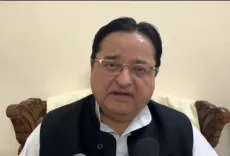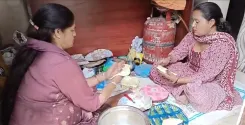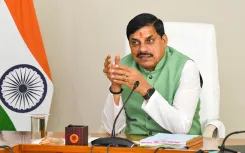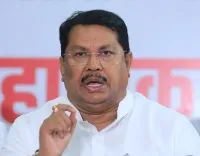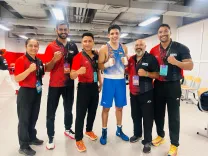What is Kharchi Puja? The Century-old Worship of 14 Deities in Tripura

Synopsis
Key Takeaways
- Kharchi Puja is a significant cultural festival in Tripura.
- It involves the worship of 14 deities over a week.
- The festival aims to cleanse sins and promote unity.
- Millions of devotees participate each year.
- The event showcases vibrant traditions and rituals.
Agartala, July 3 (NationPress) The age-old ‘Kharchi Puja’ commenced on Thursday at Puran Habeli, the historical capital of the former princely state, now referred to as Khayerpur, located approximately 8 km north of Agartala.
Tripura’s Chief Minister Manik Saha, along with various dignitaries, inaugurated this week-long ‘Kharchi Puja’, during which 14 deities are venerated simultaneously.
Millions from different regions of the country are expected to attend the fair, celebrating this historic ‘Kharchi Puja’ with great enthusiasm and traditions.
Union Home Minister Amit Shah and BJP President J.P. Nadda extended their greetings to the people of Tripura on this significant occasion.
In a post on X, HM Shah expressed: “Wishing our sisters and brothers of Tripura a blessed Kharchi Puja. May this festival strengthen our connection with Mother Earth and fill everyone’s life with joy and prosperity.”
“On this auspicious day of Kharchi Puja, I convey my warm wishes to all the brothers and sisters of Tripura. May this celebration usher in good fortune, joy, and prosperity for all. Enjoy a delightful and blessed Kharchi Puja,” J.P. Nadda mentioned in a separate post on his X account.
The annual 'Kharchi Puja' and festival aim to absolve the sins of mortal souls.
'Kharchi Puja' and Mela Committee chairman Ratan Chakraborty, who is also a BJP MLA, mentioned that approximately 15 lakh devotees and travelers from across the nation attend this unique puja and its rituals annually.
Speaking with IANS, Chakraborty, a former Minister and the Tripura Assembly Speaker, noted that if the weather remains favorable, this year's turnout of devotees and tourists is expected to surpass that of the previous year.
Nonetheless, due to unrest in Bangladesh, fewer visitors from the neighboring country may attend this year, he remarked.
Initially a festival for Hindu tribals, this 7-day Puja is now celebrated by individuals from all backgrounds and faiths.
The event features vibrant tents, lighting, religious ceremonies, and the chanting of 'mantras' accompanied by drum beats, highlighting 14 deities — Shiva, Durga, Vishnu, Laxmi, Saraswati, Kartik, Ganesha, Brahma, Abadhi (God of water), Chandra, Ganga, Agni, Kamdev, and Himadri (Himalaya).
Traditionally, the festival kicks off in June-July, marked by a colorful procession led by the Tripura Police music band.
All deities and priests are escorted by Tripura Police personnel, who also honor the Chief Royal Priest 'Raj Chantaia' with a guard of honor.
On October 15, 1949, Tripura came under Indian governance following a merger agreement signed by Kanchan Prabha Devi, the then-regent maharani, and the Indian Governor General.
This merger agreement mandated that the Tripura government continue funding 14 temples and puja ceremonies, including Kharchi Puja and Mata Tripura Sundari Temple, one of the 51 Shakti Peethas in the country, supported by the Hindu princely rulers.
According to the merger agreement, the Tripura government has been covering the festival's expenses for several decades.
Puran Habeli served as the capital of undivided Tripura until 1838, which encompassed significant areas of Sylhet, Brahmanbaria, and Comilla districts of what was then East Pakistan and is now Bangladesh.
King Krishna Manikya Bahadur (1760-1761) relocated the capital from Udaipur in southern Tripura to Puran Habeli in 1760.
The temple of the 14 gods constructed during that era still stands today. In 1838, King Krishna Kishore Manikya Bahadur (1830-1849) moved the capital to Agartala from Puran Habeli.

